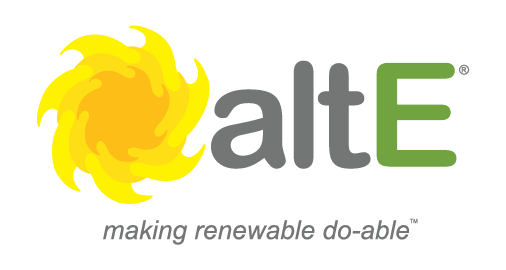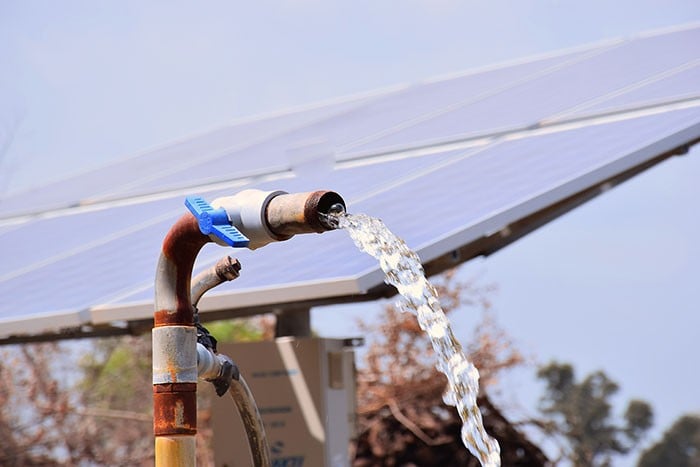Need help sizing a solar pump system? Fill out our solar water pumping questionnaire and one of our technical staff members will get busy on designing a system to meet your needs.
If you need to supply water beyond the reach of power lines, then solar power can solve the problem. Photovoltaic powered pumps provide a welcome alternative to fuel-burning engines, windmills, and hand pumps. Thousands of solar pumps are working throughout the world. They produce best during sunny weather, when the need for water is greatest.
How Does Solar Water Pumping Work?
Photovoltaic (PV) modules (i.e. solar panels) produce electricity from sunlight using silicon cells, with no moving parts. They have been mass-produced since 1979. They are so reliable that most manufacturers give a 25-year warranty, and a life expectancy well beyond 30 years. They work well in cold or hot weather.
Solar water pumps are specially designed to utilize DC electricity from solar panels. The pumps must work during low light conditions, when power is reduced, without stalling or overheating. Low volume pumps use positive displacement (volumetric) mechanisms which seal water in cavities and force it upward. Lift capacity is maintained even while pumping slowly. These mechanisms include diaphragm, vane and piston pumps. These differ from a conventional centrifugal pump that needs to spin fast to work efficiently. Centrifugal pumps are used where higher volumes are required.
A surface pump is one that is mounted at ground level. Surface pumps work well when they draw water through suction less than 10 or 20 feet. A submersible pump is one that is lowered into the water. Most deep wells use submersible pumps.
A pump controller (which is a linear current booster) is an electronic device used with most solar pumps. It acts like an automatic transmission, helping the pump to start and keeps it from stalling in weak sunlight. Some controllers also have additional features such as offering terminal for the float switch to shut off the pump when a storage tank is full and protection for overvoltage conditions.
A solar tracker may be used to tilt the PV array as the sun moves across the sky during the day. This can increase daily energy gain by as much as 55%. With more hours of peak sun, a smaller pump and power system may be used. Tracking works best in clear sunny weather. It is less effective in cloudy climates and on short winter days. However, in the last several years the cost of solar panels has come down so much that it is usually more cost effective to add more solar panels than to add a tracker. Additionally, since the tracker have moving parts they will tend to need repair after several years.
Storage is important. Three to ten days’ storage may be required, depending on climate and water usage. Most systems use water storage tanks for simplicity and economy. In other cases, batteries can be added to the system. Electrical energy from the solar modules is stored in the deep-cycle batteries so that the pump can run at non-sunny times. Add a float switch to the system which can turn the pump off when the water tank fills to prevent overflow.
Windmills, used to pump water in the “old” days, can still be seen on many horizons. More recently solar pumps have replaced windmills in water pumping applications. A small solar system turns out to be less expensive and much easier to install and maintain. The solar panels also provide a more consistent supply of water; and they can be installed in valleys and wooded areas where wind exposure is poor. A PV array may be placed some distance away from the pump itself; even several hundred feet (100 m) away.
What is Solar Water Pumping Used For?
Supply Water for your Home
Solar pumps are used for private homes, cabins, villages, medical clinics, etc. A water pump can be powered by its own PV array, or by a main system that powers lights and appliances. An elevated storage tank may be used, or a second pump called a booster pump can provide necessary water pressure. Or the main battery system can provide storage instead of a tank. Collecting rain water can supplement solar pumping when sunshine is scarce. To design a system, it helps to view the whole picture and consider all the resources.
Water for Livestock
Cattle ranchers in the Americas, Australia and Southern Africa are enthusiastic users of solar pumps. Their water sources are scattered over vast rangeland where power lines are few and costs of transport and maintenance are high. Some ranchers use solar pumps to distribute water through several miles (over 5 km) of pipelines. Others use portable systems, and move them from one water source to another.
Water for Plants
Solar pumps are used on small farms, orchards, vineyards and gardens. It is most economical to power the pump directly from the PV array (without battery), store water in a tank, and then distribute it by gravity flow. Where pressurizing is required, storage batteries stabilize the voltage for consistent flow and distribution, and may eliminate the need for a storage tank. Batteries also introduce cost, complexity and additional maintenance into the system.
Think Small with Solar Water Pumping
There are no limits to how large solar pumps can be built, but they tend to be most competitive in small installations where combustion engines are least economical. The smallest solar pumps run on less than 150 Watts of PV, and can lift water from depths exceeding 200 feet (65 m) at 1.5 gallons (5.7 liters) per minute. You may be surprised by the performance of such a small system. In a 10-hour sunny day it can lift 900 gallons (3400 liters). That’s enough to supply several families, or 30 head of cattle, or 40 fruit trees!
Slow solar pumping lets us utilize low-yield water sources. It also reduces the cost of long pipelines, since small-sized pipe may be used. The length of piping has little bearing on the energy required to pump, so water can be pushed over great distances as low cost. Small solar pumps may be installed without heavy equipment or special skills.
The most effective way to minimize the cost of solar pumping is to minimize water demand through conservation. Drip irrigation, for example, may reduce consumption to less than half that of traditional methods. In homes, low water toilets can reduce total domestic use by half. Water efficiency is a primary consideration in solar pumping economics.
A Careful Design Approach
When a generator or utility main is present, we use a relatively large pump and turn it on only as needed. With solar pumping, we don’t have this luxury. Photovoltaic panels have come down much in cost but aren’t inexpensive, per se, so we must size our systems carefully. It is like fitting a suit of clothes; you need all the measurements. For solar water pumps, first identify how much water you need per day and the vertical lift required.
Next we will determine whether a submersible pump or a surface pump is best. This is based on the nature of the water source. Submersible pumps are suited both to deep well and to surface water sources. Surface pumps can only draw water from about 20 feet (3m) below ground level, but they can push it far uphill. Where a surface pump is feasible, it is less expensive than a submersible, and a greater variety is available.
Now we need to determine the flow rate required. Here is the equation, in the simplest terms:
Gallons per Hour = Gallons Per Day / Available Peak Sun Hours per Day
“Peak Sun Hours” refers to the average equivalent hours of full-sun energy received per day. It varies with the location and the season. For example, the arid central-western USA averages 7 peak hours in summer, and dips to 4.5 peak hours in mid-winter. These Sun Hours can be considerably less in northern climates.
Next, refer to the performance charts for the type of pump that is appropriate. They will specify the size and configuration (voltage) of solar array necessary to run the pump. The charts can be found in the specification page or in the Product Documentation tab of the product’s specification page.
Copyright 1999 by Dankoff Solar Products, Inc. (Edited by altE 2016). For our latest articles on solar water pumping we recommend also checking out altE’s Solar Pumping Blog section.



